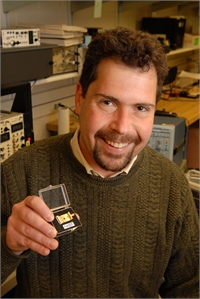Abstract: The gold standard for precision measurement of magnetic fields is the superconducting quantum interference device (SQUID). SQUID-based magnetometers are particularly important for biomagnetic imaging of the very weak fields produced by the human heart and brain. Recently, it was shown that atomic magnetometers based on the precession of spins of atoms in the vapor phase could reach sensitivities competitive with commercial SQUID sensors. These instruments do not need cryogenic cooling and hence can potentially be used in situations in which cryogenics are undesirable due to cost or difficulty of implementation. We describe recent work in the Time and Frequency Division to adapt MEMS-based technology initially developed for chip-scale atomic clocks to the field magnetometry. Magnetometers with sensitivities as low as 5 fT/Hz have been demonstrated with millimeter-scale alkali vapor cells probed by light from a semiconductor laser. The application of these sensors to biomagnetic imaging and nuclear magnetic resonance (NMR) will be discussed.
Biography: Dr. John Kitching received his BSc. in physics from McGill University in 1990. He went on to obtain a MSc. And PhD. in Applied Physics from the California Institute of Technology in 1992 and 1995, respectively. His thesis topic was an investigation of amplitude and frequency noise properties of semiconductor lasers subjected to optical feedback. From 1995 to 2003, he was with JILA/The University of Colorado and also held a guest-researcher appointment in the Time and Frequency Division at the National Institute of Standards and Technology, NIST. Since 2003, he has been a physicist in the Time and Frequency Division at NIST and currently is the Group Leader of the Atomic Devices and Instruments Group in NIST’s Physical Measurements Laboratory. His research interests include atomic clocks and frequency standards, quantum interference effects in atomic systems, and applications of semiconductor lasers to problems in atomic physics and frequency control. Most recently, he and his team pioneered the development of microfabricated atomic devices for use as frequency references, magnetometers and other sensors. He has received several awards including the 2005 EFTF European Young Scientist Award, the 2006 ISSCC Jack Raper Award for Outstanding Technology Directions, the Department of Commerce Silver Medal and the 2009 Arthur Flemming Award. He has published over 50 papers in refereed journals, has given numerous invited talks and has been awarded four patents.


